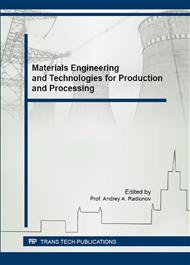[1]
J. Shinozuka, H. Yachi, T. Higashi, M. Sando, T. Maetani, S. Unami, Y. Ozaki, Effect of MnS on the cutting mechanism of powder metallurgy steel in cutting speeds ranging from 1 m/s to 150 m/s, Advanced Materials Research. 565 (2012) 370-375.
DOI: 10.4028/www.scientific.net/amr.565.370
Google Scholar
[2]
Z. Li, D. Wu, W. Lv, Application of rare earth elements in lead-free green steel, Advanced Materials Research. 518-523 (2012) 687-690.
DOI: 10.4028/www.scientific.net/amr.518-523.687
Google Scholar
[3]
Y. -Y. Yin, F. Fang, X. Yan, C. -M. Zhu, W. Chen, G. -H. Luo, J. -S. Guan, Microstructure and properties of environmental graphitized free-cutting steel, Cailiao Rechuli Xuebao/Transactions of Materials and Heat Treatment. 4 (2013) 133-137.
Google Scholar
[4]
T. Suzuki, Y. Li, Y. Koizumi, A. Chiba, Quantitative evaluation in hot workability of SUS303 free-cutting steel, Materials Science and Engineering A. 563 (2013) 117-124.
DOI: 10.1016/j.msea.2012.11.041
Google Scholar
[5]
Y. Li, T. Suzuki, N. Tang, Y. Koizumi, A. Chiba, Microstructure evolution of SUS303 free-cutting steel during hot compression process, Materials Science and Engineering A. 583 (2013) 161-168.
DOI: 10.1016/j.msea.2013.06.069
Google Scholar
[6]
T. -C. Lin, R. Zhu, C. -J. Wang, M. -G. Li, Effect of trace Bi on inclusion morphology in free-cutting steel, Kang T'ieh/Iron and Steel. 9 (2013) 77-80.
Google Scholar
[7]
M. Itabashi, H. Koseki, Mechanical characterization of pre-fatigued free-cutting steels under dynamic tension, Engineering Transactions. 2 (2013) 87-98.
Google Scholar
[8]
Y.M. Wang, X.C. Wang, L.M. Wen, Process practice of refining for free cutting austenite stainless steel, Applied Mechanics and Materials. 327 (2013) 94-96.
DOI: 10.4028/www.scientific.net/amm.325-326.94
Google Scholar
[9]
Y. -N. Wang, Y. -P. Bao, M. Wang, L. -C. Zhang, Smelting process and machinability of BN-type free cutting steel, Beijing Keji Daxue Xuebao/Journal of University of Science and Technology Beijing. 7 (2013) 869-874.
Google Scholar
[10]
J. Xu, Z. Liu, G. Guo, M. Chen, An investigation on wear mechanism of high-speed turning of free-cutting steel AISI 1215 using uncoated and multi-layer coated tools, International Journal of Advanced Manufacturing Technology. 1-4 (2013) 517-533.
DOI: 10.1007/s00170-012-4502-8
Google Scholar
[11]
X. Shao, X. Wang, M. Jiang, W. Wang, F. Huang, Y. Ji, In situ observation of MnS inclusion behavior in resulfurized free-cutting steel during heating, Jinshu Xuebao/Acta Metallurgica Sinica. 9 (2011) 1210-1215.
Google Scholar
[12]
H. Liu, W. Chen, Effect of total oxygen content on the machinability of low carbon resulfurized free cutting steel, Steel Research International. 12 (2012) 1172-1179.
DOI: 10.1002/srin.201200053
Google Scholar
[13]
H. -T. Liu, W. -Q. Chen, S. Tu, L. -S. Li, Q. -T. Lu, Q. -X. Wang, Effect of oxide inclusions on machinability of free cutting steel with low carbon and high sulphur, Journal of Iron and Steel Research. 11 (2012) 15-18.
Google Scholar
[14]
N. Matsui, N. Sano, J. Fujiwara, K. Ohishi, T. Ohkubo, K. Hono, Microscopic observation of the interface between a tool surface and deposits of low-carbon free cutting steel, Materials Transactions. 6 (2012) 1130-1137.
DOI: 10.2320/matertrans.m2012034
Google Scholar
[15]
K. -D. Xu, L. -J. Xiao, Deoxidation and inclusion control in special steel refining, Kang T'ieh/Iron and Steel. 10 (2012) 1-13.
Google Scholar
[16]
A.V. Ryabov, A.M. Panfilov, N.S. Semenova, The X-Ray–TV Investigation of Behaviour of a Bismuth SampleIntroduced to Molten Steel, Modern Applied Science. 9 (2015) 252-259.
DOI: 10.5539/mas.v9n2p244
Google Scholar
[17]
D. Wu, Z. Li, Study on the machinability of free cutting non-lead austenitic stainless steels, Advanced Materials Research. 430-432 (2012) 306-309.
DOI: 10.4028/www.scientific.net/amr.430-432.306
Google Scholar
[18]
H. -B. Wang, T. -C. Lin, R. Zhu, F. -H. Duan, L. -S. Li, Z. -Q. Zhang, Study on composition segregation of X1215 free-cutting steel continuous casting billet, Beijing Keji Daxue Xuebao/Journal of University of Science and Technology Beijing. 33 (2011).
Google Scholar
[19]
H.T. Liu, W.Q. Chen, Hot ductility of eco-friendly low carbon resulphurised free cutting steel with bismuth, Ironmaking and Steelmaking. 1 (2014) 19-25.
DOI: 10.1179/1743281212y.0000000095
Google Scholar
[20]
S. Naghdy, A. Akbarzadeh, Characterization of dynamic recrystallization parameters for a low carbon resulfurized free-cutting steel, Materials and Design. 53 (2014) 910-914.
DOI: 10.1016/j.matdes.2013.07.031
Google Scholar
[21]
S. Afshan, D. Balint, D. Farrugia, J. Lin, A new experimental method for identifying the conditions necessary for diffusion bonding in free cutting steels, Materials Science and Engineering A. 586 (2013) 25-30.
DOI: 10.1016/j.msea.2013.07.056
Google Scholar


